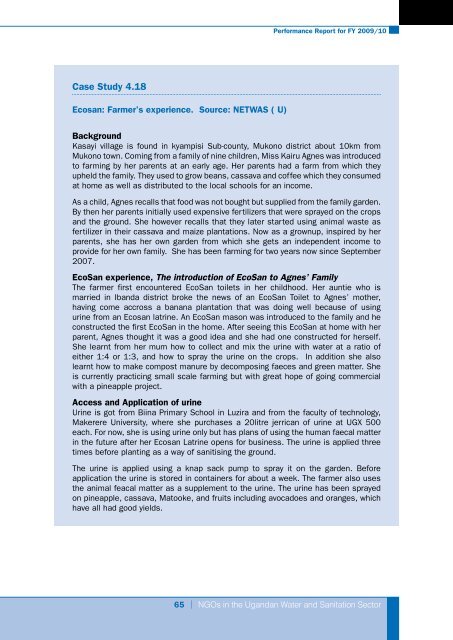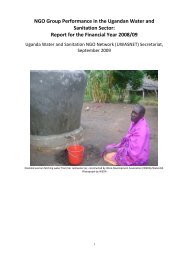Performance Report for FY 2009/10 - UWASNET
Performance Report for FY 2009/10 - UWASNET
Performance Report for FY 2009/10 - UWASNET
Create successful ePaper yourself
Turn your PDF publications into a flip-book with our unique Google optimized e-Paper software.
Case Study 4.18<br />
Ecosan: Farmer’s experience. Source: NETWAS ( U)<br />
<strong>Per<strong>for</strong>mance</strong> <strong>Report</strong> <strong>for</strong> <strong>FY</strong> <strong>2009</strong>/<strong>10</strong><br />
Background<br />
Kasayi village is found in kyampisi Sub-county, Mukono district about <strong>10</strong>km from<br />
Mukono town. Coming from a family of nine children, Miss Kairu Agnes was introduced<br />
to farming by her parents at an early age. Her parents had a farm from which they<br />
upheld the family. They used to grow beans, cassava and coffee which they consumed<br />
at home as well as distributed to the local schools <strong>for</strong> an income.<br />
As a child, Agnes recalls that food was not bought but supplied from the family garden.<br />
By then her parents initially used expensive fertilizers that were sprayed on the crops<br />
and the ground. She however recalls that they later started using animal waste as<br />
fertilizer in their cassava and maize plantations. Now as a grownup, inspired by her<br />
parents, she has her own garden from which she gets an independent income to<br />
provide <strong>for</strong> her own family. She has been farming <strong>for</strong> two years now since September<br />
2007.<br />
EcoSan experience, The introduction of EcoSan to Agnes’ Family<br />
The farmer first encountered EcoSan toilets in her childhood. Her auntie who is<br />
married in Ibanda district broke the news of an EcoSan Toilet to Agnes’ mother,<br />
having come accross a banana plantation that was doing well because of using<br />
urine from an Ecosan latrine. An EcoSan mason was introduced to the family and he<br />
constructed the first EcoSan in the home. After seeing this EcoSan at home with her<br />
parent, Agnes thought it was a good idea and she had one constructed <strong>for</strong> herself.<br />
She learnt from her mum how to collect and mix the urine with water at a ratio of<br />
either 1:4 or 1:3, and how to spray the urine on the crops. In addition she also<br />
learnt how to make compost manure by decomposing faeces and green matter. She<br />
is currently practicing small scale farming but with great hope of going commercial<br />
with a pineapple project.<br />
Access and Application of urine<br />
Urine is got from Biina Primary School in Luzira and from the faculty of technology,<br />
Makerere University, where she purchases a 20litre jerrican of urine at UGX 500<br />
each. For now, she is using urine only but has plans of using the human faecal matter<br />
in the future after her Ecosan Latrine opens <strong>for</strong> business. The urine is applied three<br />
times be<strong>for</strong>e planting as a way of sanitising the ground.<br />
The urine is applied using a knap sack pump to spray it on the garden. Be<strong>for</strong>e<br />
application the urine is stored in containers <strong>for</strong> about a week. The farmer also uses<br />
the animal feacal matter as a supplement to the urine. The urine has been sprayed<br />
on pineapple, cassava, Matooke, and fruits including avocadoes and oranges, which<br />
have all had good yields.<br />
65 | NGOs in the Ugandan Water and Sanitation Sector



